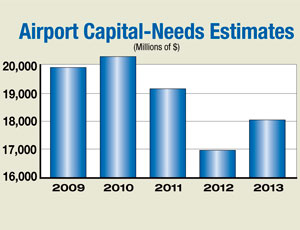Although there has been action in the House on a four-year Federal Aviation Administration reauthorization bill, it is likely that Congress instead will approve another in a series of extensions when the current stopgap FAA measure lapses on March 31.

House Transportation and Infrastructure Committee Chairman James Oberstar (D-Minn.) says it appears a six-month extension is needed to give the Senate time to work on the bill, says transportation panel spokesman Jim Berard. Such a bill would keep FAA running and its Airport Improvement Program construction grants flowing through Sept. 30, when fiscal 2009 ends.
“The key thing about passing an extension through the end of the fiscal year is that it will allow FAA to get all of the funding that is supposed to go out the door, out the door,” says Todd Hauptli, American Association of Airport Executives’ senior executive vice president.
Still, if lawmakers punt on a multiyear FAA bill, it would dampen hopes in the short term for substantial boosts in two important infrastructure funding sources: AIP and the passenger facility charges (PFCs) that airports levy.
As Congress decides its next step, airports say their infrastructure needs continue to climb, The Airports Council International-North America released a survey on March 6 that pegs capital requirements at $94.3 billion over five years, accounting for inflation. The total is up 8% from the amount in the group’s 2007 survey. Projects at large hub airports account for $55.3 billion, or 59%, of the total needs in the new survey.
Oberstar’s committee has taken a step to make a dent in those needs. It approved a bill on March 5 that would authorize $70 billion for FAA in 2009-2012, including $16.2 billion for AIP. Under the bill, AIP would get $3.9 billion in 2009 and $100-million annual hikes after that, reaching $4.2 billion in 2012. AIP’s 2008 appropriation was $3.5 billion. The committee’s bill also would raise the PFC cap to $7 per flight segment, from $4.50 now.
“A lot of things in this bill we think are very, very important,” says Greg Principato, ACI-NA’s president. He says AIP aid is “a really critically important part of the capital budget, especially [for] smaller airports.” Airports also would benefit from the recommended higher PFC level, but they had sought a $7.50 ceiling and a provision to index PFCs for future inflation.


Post a comment to this article
Report Abusive Comment